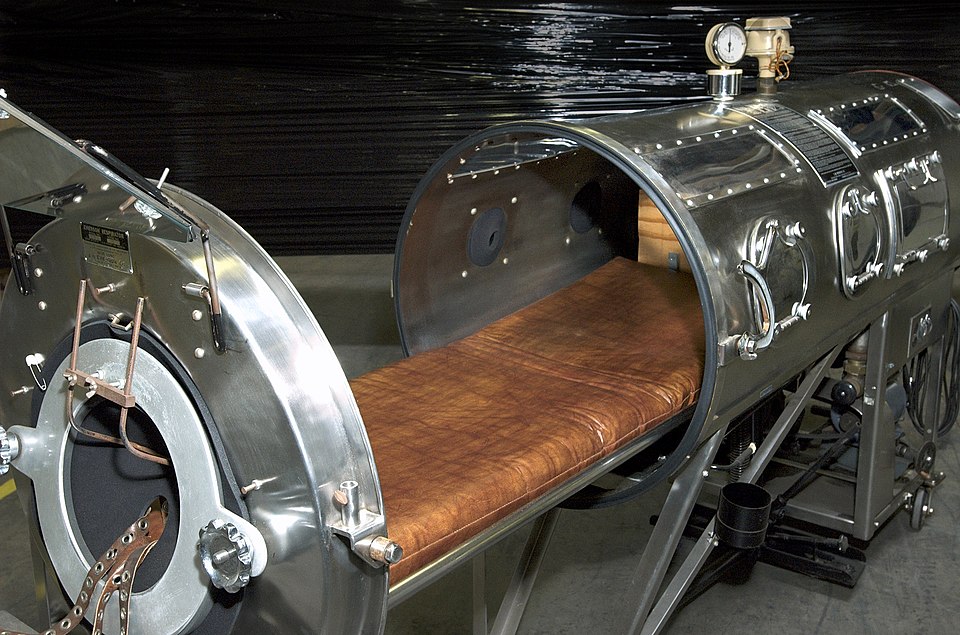
How does an iron lung work? An iron lung works by creating a space of negative pressure to inflate the lungs.
You have probably seen images of people in an iron lung. It was typically a cylindrical contraption, slightly longer then the height of the patient. It had a hole for the head to stick out of and there was an airtight seal around the neck. Anybody in an iron lung had to just lie there and they couldn’t get any part of their body out of the iron lung. The length of time a patient spent in an iron lung depended on the problem with them. Many people were only in one for a few weeks, or a few months at most. However, some people had to live in them. Paul Alexander, who died last year, spent 70 years inside an iron lung. Without one, he would not have been able to breathe.
So, how did an iron lung work? Well, first of all, iron lungs are not used these days. They have been replaced with modern ventilators. Iron lungs were needed for people that don’t have the muscle power to breathe on their own. The most common cause of that is the muscle paralysis caused by polio. When we breathe normally, our diaphragm pulls down, lowering the pressure in the chest cavity. Air always moves from an area of high pressure to an area of low pressure, so air is sucked in through our mouth and noses, down our throats, and into our lungs. When we want to breathe out, the opposite happens. The diaphragm pushes up, raising the pressure in the chest cavity. Air rushes from the high pressure area in the lungs to the lower pressure area outside, and we breathe out. We can only do this if we have working muscles. An iron lung takes over if we can’t use these muscles.
The iron lung is a completely sealed and airtight container. Because it was airtight, the pressure inside the cylinder could be controlled with an air pump. Earlier iron lungs used a bellows, and later ones used an air compressor. The iron lung could be used in the same way as regular lungs. When the air was sucked out of the iron lung, the pressure would drop and the lungs would expand. That made the pressure inside the chest cavity drop as well and air was sucked into the lungs. When air was pumped back into the iron lung, the pressure rose, it squeezed on the chest, and the air was pushed out. The rhythm of breathing was set by the machine and there was a “wooshing” sound each time the patient’s breathed. They couldn’t breathe at the speed they wanted. They also couldn’t get out of the iron lung. There were some portholes where nurses or doctors could gain access, to empty toilets, but they couldn’t be open for long because that would break the seal and the patient wouldn’t be able to breathe.
Iron lungs seem positively medieval now and they have been replaced by far more modern technology. However, when they were invented, they were state-of-the-art and they saved many people’s lives. The basic need for iron lungs was because of the polio virus. Polio does many things to the body, but one of them is to paralyze the diaphragm and the muscles in the chest. When these muscles are out of order, the patient will die pretty quickly. The iron lung was a way of saving these people. Polio has always existed, but there were outbreaks in the 1940s and 1950s. The number of iron lungs grew and some hospital wards were filled with them. A lot of children needed to be placed in iron lungs. Often, the muscles would recover after a few weeks or a few months and the patient would be able to leave the iron lung. Leaving an iron lung wasn’t a simple process though. Patients had to basically learn how to breathe because their muscles had atrophied. They would leave the iron lung and try breathing for a short while through rehab and then go back to the iron lung. They would slowly build up the amount of time they could stay outside of the lung. It sounds like a pretty terrifying experience.
Polio was eradicated by 1990 and iron lungs were replaced with positive pressure ventilators. These are ventilators that go over the mask and push air into the lungs. The patient doesn’t have to be inside a chamber and they are much easier to manage. They are also safer. The death rate of patient’s in an iron lung was about 80%. They choked on their own saliva, or the suffocated because their airways were blocked and CO2 built up. Modern ventilators can be removed and the airways cleaned, dramatically increasing the survival rate. And this is what I learned today.
Sources
https://en.wikipedia.org/wiki/Iron_lung
https://en.wikipedia.org/wiki/Poliovirus
https://www.sciencemuseum.org.uk/objects-and-stories/medicine/iron-lung
Image By Photo Credit:Content Providers(s): CDC/GHO/Mary Hilpertshauser – This media comes from the Centers for Disease Control and Prevention’s Public Health Image Library (PHIL), with identification number #6536.Note: Not all PHIL images are public domain; be sure to check copyright status and credit authors and content providers.العربية | Deutsch | English | македонски | slovenščina | +/−, Public Domain, https://commons.wikimedia.org/w/index.php?curid=714469
